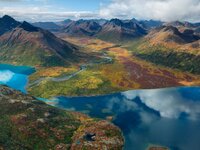Kanektok
FNG
- Joined
- Mar 5, 2024
- Messages
- 8
Long time lurker, and maybe it’s my winter boredom that's initiating this post.
I grew up in bighorn sheep country and watched state agencies establish sheep herds in various areas via relocation. Then I moved full time to AK as statewide sheep began to decline. There’s a lot of doom to listen too, and lots of directions to point fingers, but is there any conversation happening at ADFG or WSF about proactively establishing new sheep areas?
While ADFG attempted sheep transplants on Kodiak in the 1960’s, it failed likely due to coastal winter snowpack. It seems to me that this concept, at least for sheep, was prematurely abandoned. Maybe more suitable mountain ranges should be considered to increase sheep hunting opportunities for the future? (https://www.adfg.alaska.gov/static/...ife/research_pdfs/game_transplants_alaska.pdf)
For example, the Togiak National Wildlife Refuge/Wood Tikchik State Park is void of sheep. In my opinion, this seems like a waste of prime sheep habitat. The mountains are far from the coast so the snow pack can’t be worse than anywhere else in the state.
Yes, I can understand the argument that transplanting sheep from declined populations would not help immediate recovery. However, I’d argue on the statewide spectrum it would be beneficial to diversify opportunities for the longterm. Seems that carrying capacity is diminishing in the Chugach from the creeping alder line and mycoplasma ovipneumonia is showing up in some zones too.
I grew up in bighorn sheep country and watched state agencies establish sheep herds in various areas via relocation. Then I moved full time to AK as statewide sheep began to decline. There’s a lot of doom to listen too, and lots of directions to point fingers, but is there any conversation happening at ADFG or WSF about proactively establishing new sheep areas?
While ADFG attempted sheep transplants on Kodiak in the 1960’s, it failed likely due to coastal winter snowpack. It seems to me that this concept, at least for sheep, was prematurely abandoned. Maybe more suitable mountain ranges should be considered to increase sheep hunting opportunities for the future? (https://www.adfg.alaska.gov/static/...ife/research_pdfs/game_transplants_alaska.pdf)
For example, the Togiak National Wildlife Refuge/Wood Tikchik State Park is void of sheep. In my opinion, this seems like a waste of prime sheep habitat. The mountains are far from the coast so the snow pack can’t be worse than anywhere else in the state.
Yes, I can understand the argument that transplanting sheep from declined populations would not help immediate recovery. However, I’d argue on the statewide spectrum it would be beneficial to diversify opportunities for the longterm. Seems that carrying capacity is diminishing in the Chugach from the creeping alder line and mycoplasma ovipneumonia is showing up in some zones too.


